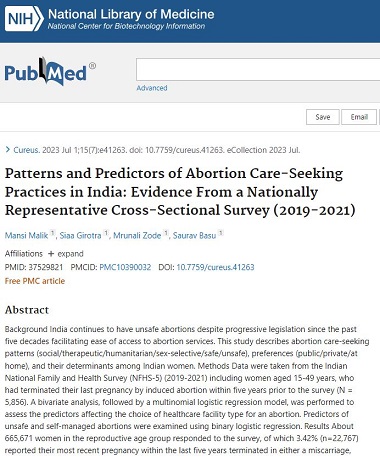
Background: India continues to have unsafe abortions despite progressive legislation since the past five decades facilitating ease of access to abortion services. This study describes abortion care-seeking patterns (social/therapeutic/humanitarian/sex-selective/safe/unsafe), preferences (public/private/at home), and their determinants among Indian women.
Methods : Data were taken from the Indian National Family and Health Survey (NFHS-5) (2019-2021) including women aged 15-49 years, who had terminated their last pregnancy by induced abortion within five years prior to the survey (N = 5,856). A bivariate analysis, followed by a multinomial logistic regression model, was performed to assess the predictors affecting the choice of healthcare facility type for an abortion. Predictors of unsafe and self-managed abortions were examined using binary logistic regression.
Results: About 665,671 women in the reproductive age group responded to the survey, of which 3.42% (n=22,767) reported their most recent pregnancy within the last five years terminated in either a miscarriage, stillbirth or abortion, of which 5,856 (25.72%) underwent an induced abortion. Women undergoing surgical abortion were more likely to avail of either a public (adjusted relative risk ratio (aRRR)=38.06 (23.62, 61.35)) or a private facility (aRRR=44.53 (28.11,70.53)) compared to at-home abortions. Women reporting a social and humanitarian reason for abortion were less likely to undergo an abortion at a public (aRRR=0.25 (0.17,0.35)) or private facility (aRRR=0.32 (0.23,0.44)) than at home. Furthermore, a total of 147 (2.43%) abortions were classified as unsafe. Women reporting sex-selective reasons for abortion were observed to have a higher likelihood of engaging in an unsafe abortion (adjusted odds ratio (aOR)= 1.61 (0.70, 3.70)) compared to those citing a therapeutic reason.
Conclusions: Self-managed abortions at home were more prevalent in women of lower socioeconomic status, adolescent girls, and those reporting sex-selective reasons for abortion. Furthermore, the reproductive-health program in India should enhance capacity-building initiatives for primary-care healthcare providers, including doctors, nurses, and pharmacists, to effectively prescribe and supervise abortion through medication methods.
Malik M, Girotra S, Zode M, Basu S. Patterns and Predictors of Abortion Care-Seeking Practices in India: Evidence From a Nationally Representative Cross-Sectional Survey (2019-2021). Cureus. 2023 Jul 1;15(7):e41263.